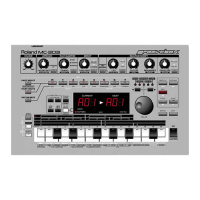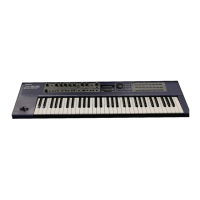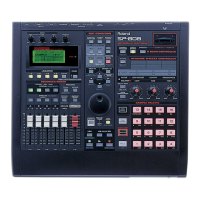To change the attack for the second tone, in step 2, set
the EDIT TARGET dial to 2ND TONE instead of 1ST
TONE, and change the attack in the same manner as
before. When you go ahead and actually have the
second tone sound, change the LAYER setting using
the previously mentioned procedure on p. 34.
✽
The attack setting is a method of adjusting a tone’s char-
acteristic peculiarities. Accordingly, the width of the
change varies with the selected tone.
Changing Tone Release (RELEASE)
With the RELEASE setting, you can change the length
of release time of the first (and second) tones you
selected with TONE#. By increasing the release time,
you get a slow and easy sound that disappears gradu-
ally, even after the strings stop vibrating. With a
short release, the sound stops immediately when you
mute a string, allowing you to play with sound that
has real bite.
<Example of the Procedure to Change the Release>
1. Select patch A43, which you used in selecting the
first tone in the section on tone numbers (TONE#),
then press [EDIT/PLAY] to enter Edit mode.
2. Set the EDIT TARGET dial to 1ST TONE, and the
PARAMETER SELECT dial to “C” (RELEASE).
3. The current value, ranging from -50 to 50 (“0” in
the example here) appears in the display.
4. Pressing [+] increases the value setting, lengthen-
ing the reverberation time. Press the [-] to
decrease the value, shortening the reverberation.
(Setting the value to “0” keeps the original sound
of the selected tone.)
➼
The width of the change you can make varies with the
selected tone.
5. When you have set a sound you like, switch the
PARAMETER SELECT dial to “WRITE PATCH?”,
and press the [+] and [-] buttons simultaneously to
wrote the patch.
➼
When saving to another patch number, before step 5,
turn the PARAMETER SELECT dial to “WRITE
TO...”, and use the [+] and [-] buttons to designate a
patch number as the destination.
To change the release of the second tone, at step 2, set
the EDIT TARGET dial to 2ND TONE instead of 1ST
TONE, and change the release in the same manner as
before. When you go ahead and actually have the
second tone sound, change the LAYER setting using
the previously mentioned procedure on p. 34.
✽
The release setting is a method of adjusting a tone’s
characteristic peculiarities. Accordingly, the width of
the change varies with the selected tone.
Changing Tone Brightness
(BRIGHTNESS)
By setting the BRIGHTNESS of the first (and second)
tones that you selected with TONE#, you can change
the brightness of the patch. Changing the value
adjusts the setting of the internal digital filter (an
effect resembling a electronic guitar’s tone knob, but
reinforced with digital circuitry) making the sound
brighter (harder) or darker (softer).
<Example of the Procedure to Change the Brightness>
1. Select patch A43, which you used in selecting the
first tone in the section on tone numbers (TONE#),
then press [EDIT/PLAY] to enter Edit mode.
2. Set the EDIT TARGET dial to 1ST TONE, and the
PARAMETER SELECT dial to “D” (BRIGHT-
NESS).
3. The current value, ranging from -50 to 50 (“0” in
the example here) appears in the display.
4. Pressing [+] increases the value setting, making
the sound bright and sharp. Press the [-] to
decrease the value, creating a dark, muffled sound.
(Setting the value to “0” keeps the original sound
of the selected tone.)
➼
The width of the change you can make varies with the
selected tone.
5. When you have set a sound you like, switch the
PARAMETER SELECT dial to “WRITE PATCH?”,
and press the [+] and [-] buttons simultaneously to
wrote the patch.
➼
When saving to another patch number, before step 5,
turn the PARAMETER SELECT dial to “WRITE
TO...”, and use the [+] and [-] buttons to designate a
patch number as the destination.
To change the brightness of the second tone, at step 2,
set the EDIT TARGET dial to 2ND TONE instead of
1ST TONE, and change the brightness in the same
manner as before. When you go ahead and actually
have the second tone sound, change the LAYER set-
ting using the previously mentioned procedure on p.
34.
✽
The brightness setting is a method of adjusting a tone’s
characteristic peculiarities. Accordingly, the width of
the change varies with the selected tone.
33
5

